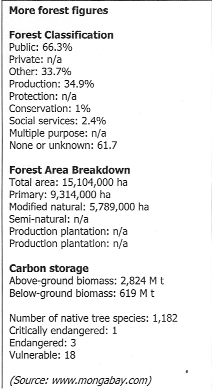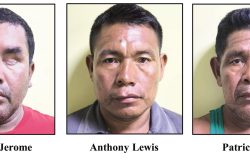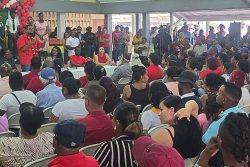Stabroek Business has agreed to publish occasional features submitted by the Office of the World Wildlife Fund in Guyana that address environmental and other critical issues in the mining and forestry sectors. The following is the first in the series of features.
World Wildlife Fund (WWF) Guianas is a non-profit environmental organization based in Guyana, Suriname and French Guiana. We are a sub-office of the WWF International network whose primary function is the conservation and protection of the world’s wildlife and ecosystems. WWF Guianas currently works in six (6) thematic areas. These are gold mining pollution abatement, protected areas establishment and management, sustainable forest management, species conservation and management, freshwater conservation and management and education and communication.
Guyana can still boast a large area of standing forest, most of it still virgin forest. This forested area covers approximately 76% of Guyana’s total land mass and is home to indigenous communities and other small groups of Guyanese.
The forests are also habitats for hundreds of species of animals and plants, some which are endemic, endangered and highly marketable both locally and internationally.
Guyana earns a significant amount of foreign exchange from export of various forest products and the sector employs at least 20 000 people.1
In 2007, the forestry sector produced a total export earning of US$61.5 million compared to US$59.5 million in 2006. The highest revenue earner was sawn wood yielding about US$21.86 million and volume at 43,825m3. This represented 35.56 per cent of export earnings. The next highest revenue earner was logs at US$20.85 million and volume at 157,097m3, representing 3.91 per cent of export earnings. Plywood export was US$8.88 million and 24,317m3, representing 14.44 per cent of export earnings2. The figure for foreign exchange earnings in non timber forest products is US$4,000,000 (2006).3
The Guyana Forestry Commission (GFC) is the key regulatory agency in Guyana’s forestry operations. Regarding the major functions of GFC, the institution is charged with advising the subject Minister on issues relating to forest policy, forestry laws and regulations. The Commission is also responsible for the administration and management of all State Forest land. Its work is guided by a Draft National Forest Plan developed to address the forest policy. The GFC develops and monitors standards for forest sector operations, develops and implements forest protection and conservation strategies, oversees forest research and provides support and guidance to forest education and training.
GFC is party to various international conventions and protocols such as the Amazon Cooperation Treaty, United Nations Convention on Biodiversity, and International Tropical Timber Agreement. GFC is working with projects from various organizations such as the World Wildlife Fund (WWF), the Canadian International Development Agency (CIDA), International Tropical Timber Organisation (ITTO), United Nations Development Programme (UNDP), TROPENBOS, and Food and Agriculture Organisation (FAO).
To date, approximately 6 million hectares of forest have been given out in concessions. There are approximately ten producers with the capacity to export large quantities of timber. Guyana’s wood is shipped mainly to the Caribbean, North America and Europe, and on a smaller scale to Asia. 4
The permanent State Forest Estate, which covers some 13.58 million hectares, is administrated by the Guyana Forestry Commission. The remaining forest areas are Pri-vate Property, Community Titled Area or State Lands administered by the Guyana Lands and Surveys Commission.
Fortunately, to date Guyana has seen less negative environmental impact from logging than from mining. A main contributor to this is the fact that Guyana has a small population, and forests are remote and difficult to navigate, especially with harvested logs. We are also fortunate that clear cutting has been limited, mainly because commercially viable trees are scattered throughout the forest.
To date, the sector has faced various challenges such as illegal logging and other malpractices, harvesting pressure on certain species, shortage of skilled personnel, high staff turnover, and land use conflicts with mining concessions 5. So far steps have been taken to address some of these issues. Malpractices have been addressed with strict penalties and fines on the logging companies in breach. Also, the Commission has begun promotion of lesser used species, value added activities. Also under consideration is a plan to phase out all log exports.
Currently there is a need for more Guyanese companies to ascribe to internationally recognized certification.
The advantage in having certification, such as the FSC certification is that the product can have wider market access and can fetch a higher price. Iwokrama Sustainable Timber Inc is currently the only timber company operating company in Guyana with Forest Soil Council (FSC) certification. This company only recently gained its certification, and was aided by technical and financial assistance from the World Wildlife Fund (WWF).
Despite the need for local companies to upgrade their operations to meet international standards, many companies (large and medium) within the forest industry find it difficult to meet the basic requirements for forest certification. The management of large forest organisations in Guyana has had a history of non compliance to sound environmental and social standards as is evidenced by the number of recorded violations of the GFC Code of Practice and the Forest Regulations by Barama Inc and some of its partners.
These breaches have undoubtedly been one of the motivating factors that prompted GFC to collaborate with Pro-Forest for the development of a Legal Verification System (LVS) for operations in the forestry sector in Guyana in 2007. This system allows companies to achieve the basic environmental, social and legal standards through a step wise process that includes an audit and provide possible solutions to problems.
Some of the environmental impacts posed by logging, especially when not in compliance with existing regulations, are disturbance of habitat caused by the building of roads, trails and skid trails. The destruction of habitat can be direct such as the felling of trees (in which many animals make their homes) for harvest or trail clearance. This can also result in the loss of endemic species. Indirect ways include noise and other disturbances which can also destroy a habitat since animals may be compelled to migrate to seek less disturbed habitat locations. It should be noted that the preservation of habitat is important to the interests of the forestry sector since many animals are shown to play a key role in the propagation of trees, many of these being key market species 6,7. Logging activity can also cause erosion of the landscape, resulting in siltation and blockage of waterways, and subsequent flooding. The opening of the canopy also increases the forest’s vulnerability to fire and changes the dynamics of the forest system.
The World Wildlife Fund (WWF)’s mission in brief, is to conserve nature and ecological processes, seek the sustainable use of natural resources, and promote the reduction of pollution and wasteful consumption while recognizing and respecting human needs and livelihoods.
Towards this end, WWF sought collaboration with GFC, Iwokrama and other key stakeholders in the forestry sector with the aim to develop Phase I of the Guianas Sustainable Forest Resources Management Project 2002-2007.
Some of the objectives of that phase included the development a forest policy; promote user-friendly forest resource use, including status maps and a database developed through a participatory process; certification working groups legally established and endorsed by government and (Forest Soil Council) FSC; harmonized national standards as proposed by the working groups; management and harvesting plans developed by two companies in Guyana and endorsed by FSC; one company certified through the FSC scheme and operating as certified Model Forest operation Units; one company certified through FSC in Chain of Custody scheme; 250,000 hectares of certified forest in Guyana and Suriname under FSC; protocols to leave untouched weak spots in concessions and community forest management protocols with a view for community forest certification.
WWF also organized training for GFC staff in communication skills and participatory techniques. GFC and WWF also collaborated in the formation of 25 community forest associations, with the aim of improving management and abating illegal logging in small hinterland communities. At the end of Phase I, WWF has seen most of these objectives satisfactorily completed.
However, this was not without facing major challenges and seeing a few lessons learnt. For instance, one of the companies involved in working towards international certification experienced major problems and lost certification after holding it for a short while. It must be noted that it is much easier for new companies to gain certification that it is for older more established ones, since a lot of restructuring and changes need to be done to attain certification. It was concluded that more follow up needs to be done with companies we work with. Also WWF faced a greater challenge in formulating a National Certification Standard in Guyana that expected. It was noted that many local logging companies do not see certification as a high priority. It was also recognised that more emphasis should be placed on sustainable forest management than just FSC certification.
WWF is currently in Phase II of the Guianas Sustainable Natural Resources Management Project which is scheduled to cover the period July 2007 – June 2011. The sub-components of the programme focus on five key areas. These are legislation and regulations improvement, institutional strengthening, improved practices support, education and awareness, monitoring and research. To date several regional workshops have been held to sensitize forestry stakeholders in Forestry Law, Inventory and Management. GFC staff have been trained in Community Forestry, Reduced Impact Logging (RIL), Environmental Impact Assessment and Geographic Information Systems. Community members of target communities have been trained in management level and pre harvest inventory, RIL techniques, business administration, marketing and sales, labour laws and standards of employment. Forest and community management plans are underway for two community forestry areas, Batavia and Kwebana. These communities have also received basic inventory equipment from WWF. It is recognized that it will be a continuous challenge to build and maintain relationships with target communities, to ensure application of sustainable forestry management.
Apart from the growing demand for timber, Guyana’s forests may come under growing demand for carbon storage in light of the current issue of greenhouse gasses and global warming. If this proves to be feasible, it could mean that Guyana can get paid significant sums of money to conserve its forests and allow them to perform their ecological function of simply absorbing carbon dioxide. This is a new concept and has a lot of potential for Guyana. This way the forest can serve other non-traditional functions, one earning carbon credits, and two generating income from eco tourism activities and research, thus opening new vistas for Guyana’s forestry sector.
WWF is in the process of deciding on how best to render the necessary financial and technical assistance in this area to assist in the maximization of Guyana’s potential to market its carbon credit resources.
For more information please visit www.wwfguianas.org. Tel 223 7802, fax 223 7801. WWF Guianas, 285 Irving Street. Queenstown. Georgetown.
References
1 (www.mongabay.com).
2 (http://www.stabroeknews.com/index.pl/article_general_news?id=56537349)
3 Tinde van Andel and Marileen Reinders. Non Timber Forest Products in Guyana’s north West district: Potentials and Pitfalls. (Utrecht University /Tropenbos-Guyana Programme) – url : http://www.tropenbos.nl/files/NTFP/Andel.PDF
4 http://www.stabroeknews.com/index.pl/article_general_news?id=56537349)
5. MacQueen, D.J. 2001, Evidence based policies for good governance. The applicability of growth and yield
modeling in the Guyana Forest Sector. IIED.
6 http://news.mongabay.com/2008/0609-lapenta_tcs.html
7 http://news.mongabay.com/2008/0612-madagascar.html










